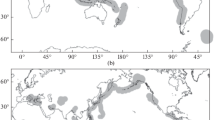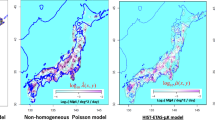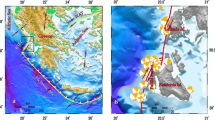Abstract
We have applied a variation of the Epidemic Type Aftershock Sequence (ETAS) model, which is a stochastic triggering epidemic model incorporating short-term clustering, to data collected by the New Zealand Seismological Observatory-Wellington (Geonet) for forecasting earthquakes of moderate and large magnitude in the New Zealand region. The model uses earthquake data only, with no explicit use of tectonic, geologic, or geodetic information. In this epidemic-type model every earthquake is regarded, at the same time, as being triggered by previous events and triggering following earthquakes. A maximum likelihood estimate of the model parameters has been performed on the learning period from 1960 to 2005 for earthquakes of magnitude 4.0 and larger. Forecast verification procedures have been carried out in a forward-retrospective way on the January 2006 to April 2008 data set, making use of statistical tools as the log-likelihood ratio, the Relative Operating Characteristics (ROC) diagrams, the Molchan error diagrams, the probability gain and the R-score. These procedures show that the clustering epidemic model achieves a log-likelihood ratio per event of the order of some units, and a probability gain up to several hundred times larger than a time-independent spatially uniform random forecasting hypothesis. The results show also that a significant component of the probability gain is linked to the time-independent spatial distribution of the seismicity used in the model.













Similar content being viewed by others
References
Aki, K. (1981), A probabilistic synthesis of precursory phenomena. In Earthquake Prediction, Am. Geophys. Union. Washington, pp. 556–574.
Baiesi, M. (2006), Scaling and precursor motifs in earthquake networks, Physica A, 360(2), 534–542.
Chen, C.-C., Rundle, J.B., Li, H.-C., Holliday, J.R., Nanjo, K.Z., Turcotte, D.L. and Tiampo, K.F. (2006), From tornados to earthquakes: forecast verification for binary events applied to the 1999 Chi-Chi, Taiwan, Earthquake, Terr. Atmos. Ovean. Sci. 17, 3, 503–516.
Console, R. (2001), Testing earthquake forecast hypotheses, Tectonophysics, 338, 261–268.
Console, R. and Murru, M. (2001), A simple and testable model for earthquake clustering, J. Geophys. Res. 106, 8699–8711.
Console, R., Murru, M. and Lombardi, A.M. (2003), Refining earthquake clustering models, J. Geophys. Res. 108, 2468, doi:10.1029/2002JB002130.
Console, R., Murru, M. and Catalli, F. (2006a), Physical and stochastic models of earthquake clustering, Tectonophysics 417, 141–153.
Console, R., Rhoades, D.A., Murru, M., Evison, F.F., Papadimitriou, E.E. and Karakostas, V.G. (2006b), Comparative performance of time-invariant, long-range and short-range forecasting models on the earthquake catalogue of Greece, J. Geophys. Res. 111, B09304, doi:10.1029/2005JB004113.
Console, R., Murru, M., Catalli, F. and Falcone, G. (2007), Real time forecasts through an earthquake clustering model constrained by the rate-and-state constitutive law: Comparison with a purely stochastic ETAS model, Seismol. Res. Lett. 78, 49–56.
Console, R., Murru, M. and Falcone, G. (2010), Probability gains of an epidemic-type aftershock sequence model in retrospective forecasting of M ≥ 5 earthquakes in Italy, J. Seismol. 14, 9–26.
Console, R., Jackson, D.D. and Kagan, Y.Y. (2010), Using the ETAS model for catalog declustering and seismic background assessment, Pure Appl. Geophys. Seismogenesis and Earthquake Forecasting: The Frank Evison Volume, this issue.
Daley, D.J. and Vere-Jones, D. (2003), An introduction to the Theory of Point Processes, 2-nd ed., vol. 1 (Springer-Verlag, New York), p. 469.
Daley, D.J. and Vere-Jones, D. (2004), Scoring probability forecasts for point processes: The entropy score and information gain, J. Appl. Prob. 41A, 297–312.
Faenza, L., Hainzl, S., Scherbaum, F. and Beauval, C. (2007), Statistical analysis of time dependent earthquake occurrence and its impact on hazard in the low seismicity region Lower Rhine Embayment, Geophys. J. Int. 171(2), 797–806.
Felzer, K.R., Becker, T.W., Abercrombie, R.E., Ekstróm, G. and Rice, J.R. (2002), Triggering of the 1999 M w 7.1 Hector Mine earthquake by aftershocks of the 1992 M w 7.3 Landers earthquake, J. Geophys. Res. 107(B9), 2190, doi:10.1029/2001JB000911.2002.
Frankel, A. (1995), Mapping seismic hazard in the central and eastern United States, Seismol. Res. Lett. 66, 8–21.
Hanssen, A.W. and Kuipers, W.J.A. (1965), On the relationship between frequency of rain and various meteorological parameters, Mededelingen en Verhandelingen, 81, 2–15.
Harte, D. and Vere-Jones, D. (2005), The entropy score and its uses in earthquake forecasting, In (Ben-Zion, Y, R. Zuniga and D. Vere-Jones, Eds), Statistical Seismology, Pure Appl. Geophys. 162, 1229–1253.
Helmstetter, A. and Sornette, D. (2002), Subcritical and supercritical regimes in epidemic models of earthquake aftershocks, J. Geophys. Res. 107(B10), 2237, doi:10.1029/2001JB001580.
Helmstetter, A. and Sornette, D. (2003), Predictability in the Epidemic-Type Aftershock Sequence model of interacting triggered seismicity, J. Geophys. Res. 108(B10), 2482, doi:10.1029/2003JB002485, 2003.
Helmstetter, A., Kagan, Y.Y. and Jackson, D.D. (2006), Comparison of short-term and time-independent earthquake forecast models for southern California, Bull. Seismol. Soc. Am. 96(1), 90–106.
Holliday, J.R., Nanjo, K.Z., Tiampo, K.F., Rundle, J.B. and Turcotte, D.L. (2005), Earthquake forecasting and its verification, Nonlinear Proc. Geophys. 12, 965–977.
Imoto, M. (2004), Probability gain expected for renewal models, Earth Planets Space 56, 561–571.
Kagan, Y.Y. (1991), Likelihood analysis of earthquake catalogues, Geophys. J. Int. 106, 135–148.
Kagan, Y.Y. (2002), Aftershock zone scaling, Bull. Seismol. Soc. Am. 92(2), 641–655.
Kagan, Y.Y. and Jackson, D.D. (1994), Long-term probabilistic forecasting of earthquakes, J. Geophys. Res. 99, 13,685–13,700.
Kagan, Y.Y. and Jackson, D.D. (1995), New seismic gap hypothesis: five years later, J. Geophys. Res. 100, 3,943–3,959.
Kagan, Y.Y. and Jackson, D.D. (2000), Probabilistic forecasting of earthquakes, Geophys. J. Int. 143, 438–453.
Kagan, Y.Y. and Knopoff, L. (1977), Earthquake risk prediction as a stochastic process, Phys. Earth Planet. Inter. 14 (2), 97–108.
Kagan, Y.Y., Bird, P. and Jackson, D.D. (2010), Earthquake patterns in diverse tectonic zones of the globe, Pure Appl. Geophys. Seismogenesis and Earthquake Forecasting: The Frank Evison Volume, this issue.
Kossobokov, V.G. (2006), Testing earthquake prediction methods: “The West Pacific short-term forecast of earthquakes with magnitude M w HRV ≥ 5.8”, Tectonophysics 413(1–2), 25–31.
Ma, L. and Zhuang, J. (2001), Relative quiescence within the Jiashi Swarm in Xinjiang, China: An application of the ETAS point process model, J. Appl. Prob. 38, Probability, Statistics and Seismology, 213–221.
Matthews, M.M. and Reasenberg, P.P. (1988), Statistical methods for investigating quiescence and other temporal seismicity patterns, Pure Appl. Geophys. 126, 2–4, 357–372.
McGuire, J.J., Boettcher, M.S. and Jordan, T.H. (2005), Foreshock sequences and short-term earthquake predictability on East Pacific Rise transform faults, Nature 434(7032), 457–461; Correction-Nature 435(7041), 528.
Molchan, G.M. (1990), Strategies in strong earthquake prediction, Phys. Earth Planet. Inter. 61 (1–2), 84–98.
Molchan, G.M. (1997), Earthquake prediction as a decision-making problem, Pure Appl. Geophys. 149 (1), 233–247.
Molchan, G.M. (2003), Earthquake prediction strategies: A theoretical analysis. In: (Keilis-Borok, V.I. and Soloviev, A.A., eds) Nonlinear Dynamics of the Lithosphere and Earthquake Prediction (Springer, Heidelberg, 2003), pp. 208–237.
Molchan, G.M. and Kagan, Y.Y. (1992), Earthquake prediction and its optimization, J. Geophys. Res. 97, 4823–4838.
Murru, M., Console, R. and Falcone, G. (2009), Real-time earthquake forecasting in Italy, Tectonophysics. 3–4, 214–223.
Ogata, Y. (1998), Space–time point-process models for earthquake occurrences, Ann. Inst. Statist. Math. 50, 2, 379–402.
Ogata, Y. (2001), Increased probability of large earthquakes near aftershock regions with relative quiescence, J. Geophys. Res. 106, B5, 8729–8744.
Ogata, Y. (2004a), Space-time model for regional seismicity and detection of crustal stress changes, J. Geophys. Res. 109, B3, B03308, doi:10.1029/2003JB002621.
Ogata, Y. (2004b), Seismicity quiescence and activation in western Japan associated with the 1944 and 1946 great earthquakes near the Nankai trough, J. Geophys. Res. 109, B4, B04305, doi:10.1029/2003JB002634.
Ogata, Y. (2005), Synchronous seismicity changes in and around the northern Japan preceding the 2003 Tokachi-oki earthquake of M 8.0, J. Geophys. Res. 110, B5, B08305, doi:10.1029/2004JB003323.
Ogata, Y. (2006a), Monitoring of anomaly in the aftershock sequence of the 2005 earthquake of M 7.0 off coast of the western Fukuoka, Japan, by the ETAS model, Geophys. Res. Lett. 33, 1, L01303, doi:10.1029/2005GL024405.
Ogata, Y. (2006b), Seismicity anomaly scenario prior to the major recurrent earthquakes off the east coast of Miyagi Prefecture, northern Japan, Tectonophysics 424, 291–306, doi:10.1016/j.tecto.2006.03.038.
Ogata, Y. (2007), Seismicity and geodetic anomalies in a wide area preceding the Niigata-Ken-Chuetsu earthquake of 23 October 2004, central Japan, J. Geophys. Res. 112, B10301, doi:10.1029/2006JB004697.
Ogata, Y. and Katsura, K. (1993), Analysis of temporal and spatial heterogeneity of magnitude frequency distribution inferred from earthquake catalogues, Geophys. J. Int. 113, 727–738.
Ogata, Y. and Katsura, K. (2006), Immediate and updated forecasting of aftershock hazard, Geophys. Res. Lett. 33, 10, L10305, doi:10.1029/2006GL025888.
Ogata, Y. and Zhuang, J. (2006), Space-time ETAS models and an improved extension, Tectonophysics 413, 13–23.
Ogata, Y., Jones, L.M. and Toda, S. (2003), When and where the aftershock activity was depressed: Contrasting decay patterns of the proximate large earthquakes in southern California, J. Geophys. Res. 108, B6, 2318, doi:10.1029/2002JB002009 (1-12).
Rhoades, D.A. and Evison, F.F. (1989), On the reliability of precursors, Phys. Earth Planet. Int. 58, 137–140.
Saichev, A. and Sornette, D. (2006), Renormalization of branching models of triggered seismicity from total to observable seismicity, Eur. Phys. J. B 51, 443–459, doi:10.1140/epjb/e2006-00242-6.
Shi, Y. and Bolt, B. (1982), The standard error of the magnitude frequency b value, Bull. Seism. Soc. Am. 72, 1677–1687.
Shi, Y., Liu, J. and Zhang, G. (2001), An evaluation of Chinese annual earthquake predictions, 1990–1998, J. Appl. Probab. 38A, 222–231.
Vere-Jones, D. (1998), Probabilities and information gain for earthquake forecasting, Comput. Seismol., 30, Geos, Moscow, 248–263.
Zechar, J.D. and Jordan, T.H. (2008), Testing alarm-based earthquake predictions, Geophys. J. Int. 172, 715–724.
Zhuang, J., Ogata, Y. and Vere-Jones, D. (2004), Analyzing earthquake clustering features by using stochastic reconstruction, J. Geophys. Res. 109, B5, B05301, doi:10.1029/2003JB002879.
Zhuang, J., Chang, C., Ogata, Y. and Chen, Y. (2005), A study on the background and clustering seismicity in the Taiwan region by using point process models, J. Geophys. Res. 110, B5, B05S18, doi:10.1029/2004JB003157.
Acknowledgments
The authors are grateful to two anonymous reviewers for their suggestions that greatly improved the quality of the manuscript, and to Matt Gerstenberger, who has carried out a careful editorial revision of the manuscript.
Author information
Authors and Affiliations
Corresponding author
Rights and permissions
About this article
Cite this article
Console, R., Murru, M. & Falcone, G. Retrospective Forecasting of M ≥ 4.0 Earthquakes in New Zealand. Pure Appl. Geophys. 167, 693–707 (2010). https://doi.org/10.1007/s00024-010-0068-2
Received:
Revised:
Accepted:
Published:
Issue Date:
DOI: https://doi.org/10.1007/s00024-010-0068-2




